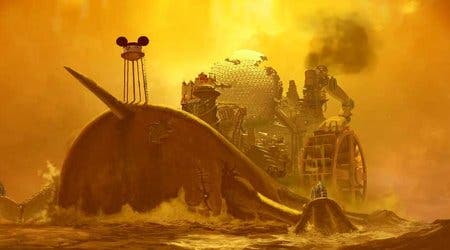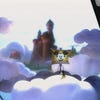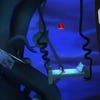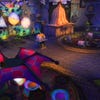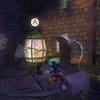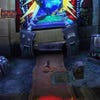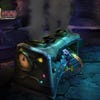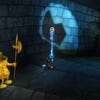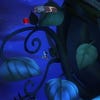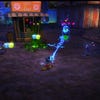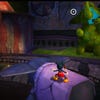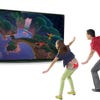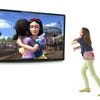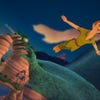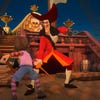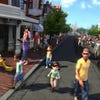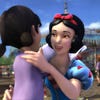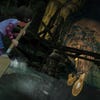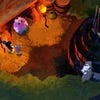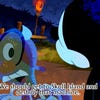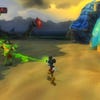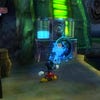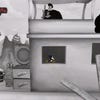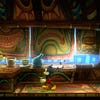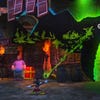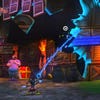A Tale of Two Mickeys
Video games on Disneyland: From the Magic Kingdom to the Wasteland.
Disneyland's quietly becoming a bit of a video game star. In the last 18 months, it's provided the inspiration for two separate big budget releases: Junction Point's troubled - and dangerously lavish - Wii oddity Epic Mickey, and Frontier's lovely Kinect: Disneyland Adventures.
Yet while both titles share a central preoccupation - an aging resort on the outskirts of Los Angeles - the end results couldn't have less in common. Two games, one park: why are the final products so different?
To answer that question, it might be wise to start with the park itself - specifically, the park's rather strange relationship with reality. This is the relationship that both games, in their own way, are quietly obsessed with, and the best way of understanding it might be to examine the case of a landmark Disneyland attraction that opened back in 1969.
The Haunted Mansion is amongst the best dark rides at the park, which means, I guess, that it's amongst the best dark rides anywhere. What's fascinating, though, is that it almost didn't get built - or at least, not in its current form.
It features in both Epic Mickey and Disneyland Adventures, but, as far as the real world's concerned, visitors to the Anaheim park can find it lurking at the edge of New Orleans Square, a short walk from Pirates of the Caribbean. Inside, you're offered a magnificently spooky ramble through a creepy old house filled with moving paintings, hitch-hiking spectres, and a barber's shop quartet composed of plaster busts.
In Grim Grinning Ghosts, it has the best song of any Disneyland ride, and with the Doom Buggies, it has the best means of transportation, too. The buggies are weird gothic constructions with high backs and deep seats, and they spin you around as you move through the attraction, turning left so you can see a gathering of ghouls dancing in a ballroom, and then swinging right again so you can chat to the sinister medium Madame Leota - or her head, at least, which now resides inside a crystal ball set up on a small, cloth-covered table in the music room.
Outside, it's a faded southern manor, surrounded by sickly weeds and tombstones, and here's where the ride almost got itself into trouble. Walt Disney was perfectly happy to have a haunted house attraction in his park - I think it was actually part of the earliest plans he drew up - but he wasn't prepared to lower the tone of New Orleans Square with a building that looked like a derelict. It took a lot of negotiating for the imagineers to convince Disney that the Haunted Mansion should be haunted on the outside as well as on the inside.
It's a story that cuts straight to the heart of what's so interesting about Disneyland -and why the place may seem so appealing to video game designers. The park's a nexus for many different worlds, and many different ideas, and they rub together in fascinating ways. Each ride is a combination of impossible landscapes and hidden engineering - a curious convergence of daydream and pragmatism that may be familiar to anyone who's ever put together an Elite or a Deus Ex. Each exterior, meanwhile, is a struggle between conflicting artifices: should it reflect the fantasy realm of the ride that lurks on the inside, or the separate, often unrelated fantasy of the park that surrounds it?
This is the contradiction that allows Disneyland's innocent-looking facades to hide anything from a journey over the sleeping streets of Peter Pan's London to a trip through the bayou and down into Hell with a gaggle of singing pirates, and it's a contradiction that both Junction Point's and Frontier's games exploit. This is where things get a little topsy-turvy, though, since the game that is theoretically more closely connected to the real world - Kinect: Disneyland Adventures, which simulates a trip to the actual park - is often significantly less attached to reality than the one that stars Mickey Mouse as, you know, a platforming hero armed with a magical paintbrush.
That's not to say Frontier's game isn't accurate, for the most part. In fact, it's captured the park in amazing detail, from the turnstiles and lockers of the front entrance to the churro carts that litter the open spaces of Main Street USA and Fantasyland. There's a pretty good magic trick store on Main Street, and I'm fairly certain it's actually visible in the game, too. So are the rails for the streetcar, and so is the collection point for kids who have lost track of their parents. The developers have even included queues of punters that snake back and forth outside the rides.
But it's with the rides themselves that the game starts to indulge in a little fantasy. David Braben's suggested that the team saw Disneyland Adventures as an opportunity to build on the imagineers' existing work: to create the impossible versions of the likes of Space Mountain, Peter Pan's Flight, and the Matterhorn that only video games could deliver.
The results are often dazzling. Pirates of the Caribbean no longer leaves you floating past a buccaneer party in full swing, for instance. Now, you're rowing through the swamps, sneaking through the cobbled streets of a rowdy port, and engaging in sword fights and even dance-offs. The Haunted Mansion finally lets you out of those Doom Buggies so you can skulk around in the darkness, even if you are still on rails. You get to hunt ghosts instead of just watch them whizz by, while Madame Leota's been freed from her séance table and now zips through the air around you.
Almost every ride gets the video game treatment, with only Small World hinting at the mechanisms and trickery that power the real attraction. In Epic Mickey, paradoxically, exposing mechanisms and trickery is the order of the day.
The thing about Junction Point's surprisingly melancholic look at the Magic Kingdom that most intrigues me is its relationship to the real entertainment industry. While the game's gorgeous opening cinematic has Mickey being sucked into an enchanted version of the park that's been created by a wizard, once you're there, you're in a world of detailed artifice that's been brilliantly laid bare - a landscape built of pipes, clockwork, and shabby cardboard facades.
The boats are jammed on Epic Mickey's strange, decrepit version of Small World, while the elephants on the Dumbo ride are patched and battered. The Haunted Mansion's famous Stretching Room - a telescoping chamber that takes you from the entrance of the house and down to the Doom Buggy's track - is powered by thundering cogs and pistons here, which is in sharp contrast to the attraction's treatment in Disneyland Adventures, which turned it into an unashamedly magical plummet through a fragmented tunnel littered with cobwebs and floating candelabra.
Main Street meanwhile - it's now called Mean Street - has become a controlled study in false perspectives. Most of its shop fronts are no more than thin layers of paint, and most of its alleyways are pictures sketched on sheets of canvas. All video game hub worlds like to suggest more real estate than they actually deliver, but Epic Mickey is stylishly honest about it, too.
Everywhere you look, in other words, you see the compromises and realities behind Disney's luminous fantasies. The 2D platforming interludes between zones recreate sequences from classic Disney shorts, but they also relish in showing how drab and flaking the backdrops are. The game's very best level sees you scaling a mountain, but it's a mountain made of shattered Disney merchandising: the company's famous stars plastered over acres of tacky junk, thrown out and forgotten.
It's no wonder reviewers - particularly outside of America - seemed so confused. Half the game is built from references to the Enchanted Tiki Room and other obscure Disneyland attractions, while the other half is a peculiarly clear-eyed look at marketing and fabrication - a vision not of the final product, but of the process itself and the garbage that surrounds it.
The differences in the two games come down to audience, I suspect. Disneyland Adventures is very much a game for children, so you're offered a fairly literal interpretation of the park on the surface, before you step indoors to see the rides like kids see them: as magical spaces where the normal laws of reality don't apply. Epic Mickey, meanwhile, is a game that I have a feeling may actually be aimed at adults.
It's about a version of Disneyland that has long been forgotten, and it's a look at the park that revels in the things that a lot of grown-ups tend to enjoy about it. Things like the engineering cleverness that's on display all around you: the way that rides are slotted together efficiently, and driven by everything from lasers and animatronics right through to the kind of tricks that 19th century magicians relied upon.
Kids enjoy the show, then, while adults appreciate the showmanship. Thanks to video games, though - confident charmers like Disneyland Adventures and even weird, difficult offerings like Epic Mickey - we can all get a chance to poke around the park and emerge with something to remember.
